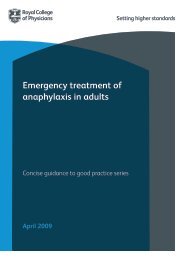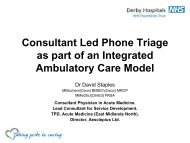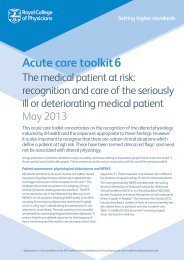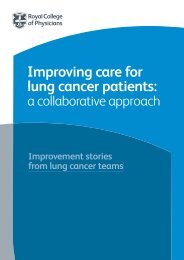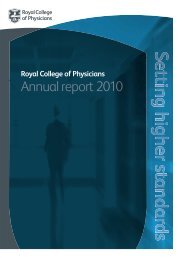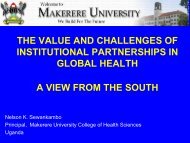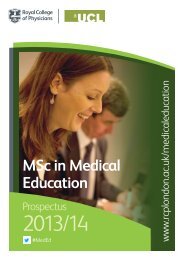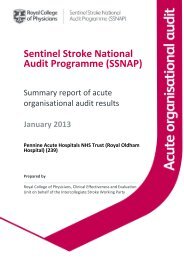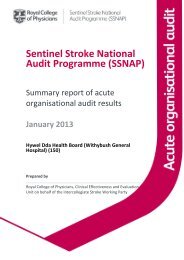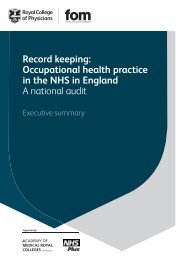Consultant physicians working with patients - Royal College of ...
Consultant physicians working with patients - Royal College of ...
Consultant physicians working with patients - Royal College of ...
Create successful ePaper yourself
Turn your PDF publications into a flip-book with our unique Google optimized e-Paper software.
<strong>Consultant</strong> <strong>physicians</strong> <strong>working</strong> <strong>with</strong> <strong>patients</strong>Table 1 Incidence <strong>of</strong> haematological disease and numbers <strong>of</strong> <strong>patients</strong> seen annuallyPopulationDisease or treatment England and Wales Per 1,000,000 Per 500,000 Per 250,000Acute leukaemia 2,400 48 24 12CML 500 10 5 2–3CLL 4,000 80 40 20NHL – high grade 2,000 40 20 10NHL – low grade 5,000 100 50 25Hodgkin’s lymphoma 1,200 24 12 6Myeloma 3,000 60 30 15MDS, MPD and other 2,000 40 20 10Oral anticoagulant treatment 520,000 10,000 5,000 2,500Venous thrombosis 78,000 1,500 750 375Thrombophilia 2,600,000 50,000 25,000 12,500Symptomatic thrombophilia 30,000 600 300 150CLL = chronic lymphocytic leukaemia; CML = chronic myeloid leukaemia; MDS = myelodsyplastic syndrome;MPD = myeloproliferative disease; NHL = non-Hodgkin’s lymphoma.Patients require comprehensive care, which may includechronic transfusion programmes, iron chelation andfrequent hospital admissions for the treatment <strong>of</strong> sicklecrisis. National standards for the management <strong>of</strong><strong>patients</strong> <strong>with</strong> haemoglobinopathies direct serviceswhich are delivered in the secondary and tertiary caresettings and in the community. Linked newborn andantenatal screening for haemoglobinopathy is aDepartment <strong>of</strong> Health (DH) initiative that requires adesignated lead clinician and careful links <strong>with</strong> obstetricclinics.Thrombosis and haemostasisThe care <strong>of</strong> <strong>patients</strong> <strong>with</strong> haemophilia and otherinherited bleeding disorders is organised throughhaemophilia comprehensive care centres usingmanagement guidelines produced by the UKHaemophilia Centre Doctors’ Organisation(UKHCDO) and the National Service Specification forBleeding Disorders. Patients require lifelong care, <strong>with</strong>input from other disciplines including orthopaedics.A consultant haematologist in each hospital is <strong>of</strong>tenresponsible for supervising the control <strong>of</strong> oralanticoagulants (OACs). The consultant may also lead athrombosis service, directing a multidisciplinaryapproach to the management <strong>of</strong> the risk <strong>of</strong> thrombosisand the investigation and treatment <strong>of</strong> venousthromboembolism (VTE). This aspect <strong>of</strong> a consultanthaematologist’s work increased significantly during2010 following the development <strong>of</strong> national targets inEngland for VTE risk assessment that have been set inthe Commissioning for Quality and Innovation(CQUIN) payment framework and the publication <strong>of</strong>the NICE standards on the prevention <strong>of</strong> VTE.Transfusion medicineOne consultant haematologist is usually responsible forthe hospital blood bank and transfusion services. Theconsultant will be a member <strong>of</strong> the hospital transfusioncommittee, together <strong>with</strong> a specialist practitioner <strong>of</strong>transfusion (SPOT) and the senior biomedical scientist(BMS) <strong>of</strong> the hospital blood bank. This team isresponsible for ensuring that appropriate policies andguidelines are in place to guarantee the safety <strong>of</strong> bloodtransfusion and the best use <strong>of</strong> blood to meet therequirements <strong>of</strong> British and European legislation.Hospital blood banks must ensure that all bloodcomponents can be traced accurately from donor torecipient.128 C○ <strong>Royal</strong> <strong>College</strong> <strong>of</strong> Physicians 2013



